Tom's Guide Verdict
The Zenfone 8 is a compact, powerful phone. WIth its top-tier specs and decent camera performance, it punches well above its weight, especially given this price point.
Pros
- +
Compact and easy to handle
- +
Clean, minimal software
- +
Excellent performance
- +
Good cameras
Cons
- -
No wireless charging
- -
Portrait mode leaves a lot to be desired
Why you can trust Tom's Guide
OS: Android 11 / ZenUI 8
Display: 5.9-inch AMOLED (2400 x 1080)
Refresh rate: 120 Hz
CPU: Snapdragon 888
RAM: 6GB, 8GB, 16GB
Storage: 128GB, 256GB
Rear cameras: 64MP (f/1.8) main, 12MP (f/2.2) ultrawide
Front camera: 12MP
Battery: 4,000 mAh
Battery life (Hrs:Mins): 10:52 (60Hz) / 10:16 (90Hz) / 9:58
(120Hz)
Charging speed: 30W
Colors: Obsidian Black, Horizon Silver
Size: 5.9 x 2.7 x 0.4 inches
Weight: 5.96 ounces
The Asus Zenfone 8 is here and it’s quite the head-turner. Asus may be a big name in the computing world, but it’s quite the underdog when it comes to phones. A few years back, the company rejected camera notches and cutouts, turning to a flipping camera module on the Zenfone 6. But the Zenfone 8 takes a more conventional approach to smartphone design and refines it. It does this in a small, compact frame with a ton of horsepower, a great display and good cameras.
With a large battery, a fast-refreshing display, and a headphone jack, the Zenfone 8 ticks all of the boxes for what we’d look for in a great smartphone. The only question is one of availability: at this point, we don’t know if or when this is coming to North America.
Despite that, the Zenfone 8 is an excellent device and perfect for people who want the most power out of their small phone. This is easily the best small Android phone with a screen that’s smaller than 6 inches. Read our full Zenfone 8 review to find out why.
Asus Zenfone 8 review: Price and availability
Asus has not yet revealed full pricing and availability, though we do know that the phone will start at €599. That's for the model with 6GB of RAM and 128GB of storage.
The Zenfone 8 also comes in 8GB and 16GB flavors. You can pair that 8GB of RAM with either 128GB or 256GB of storage. The 16GB version comes with 256GB.
We still don't know full pricing and availability, but stay tuned for an update when we find out more.
Asus Zenfone 8 review: Design
From all appearances, the Zenfone 8 is quite unassuming. In fact, it looks a bit like phones from a few years ago. The metal body curves to fit your hand and I love that. The phone is very small by modern standards, with a sub-6 inch display, just like the best small phones.
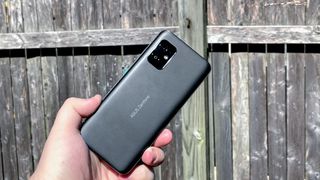
The dual lens camera module protrudes ever so slightly from the back of the Zenfone 8, and the front camera sits in a hole punch cutout in the top left corner of the display.

On the Obsidian Black model I tested for this Zenfone 8 review, the power button is a blue that contrasts well with the dark frame. The Zenfone 8 also packs in a wonderful surprise: a 3.5mm headphone jack.

The compact body makes one-handing it a breeze. It’s also IP68 rated, so you need not worry about water being an issue. There’s an in-display optical fingerprint sensor, which worked quite well in my experience.
Frankly, the only thing missing from the Zenfone 8 is a micro SD card slot. The lack of wireless charging due to the metallic body is a bummer, but no phone can be perfect. All told, I love the phone’s subdued design.
At 5.9 x 2.7 x 0.4 inches, the Zenfone 8 is a diminutive little guy. I enjoy picking it up, especially given how accustomed to big phones I am. Asus did a great job on build quality and design.
Asus Zenfone 8 review: Display
Coming in at 5.9 inches, the Zenfone 8’s AMOLED display is pretty small in this age of giant phablets. It packs a FHD+ resolution and up to 120 Hz on the refresh rate. You’ll get punchy colors and deep blacks with excellent viewing angles, too.

You can lock the Zenfone 8’s display at 60Hz, 90Hz, or 120Hz. Or you can leave it in the auto mode, and the phone will adjust the refresh rate as needed, like we’ve seen on other phones recently.
While not quite as striking as the OnePlus 9’s display, the Zenfone 8’s screen is still very good. In our testing, it reproduced 154.5% of the sRGB spectrum and 109.5% of the DCI-P3 gamut in its default color profile. It managed a Delta-E score of 0.27 — 0 is perfect, so the lower the number, the better.
Compare that to the OnePlus 9’s Delta-E of 0.28 for its AMOLED panel. That phone managed 199.4% of the sRGB and 141.3 of the DCI-P3 color gamuts in its default mode. The Zenfone 8 gets brighter in our testing at 727 nits versus the OnePlus 9’s 696 nits.
Asus Zenfone 8 review: Cameras
The Zenfone 8 uses two camera lenses, not unlike the Pixel 5. It has a 64MP wide-angle primary shooter and a 12MP ultrawide lens. For reference, the Pixel 5 has a 12.2MP primary and 16MP ultrawide.
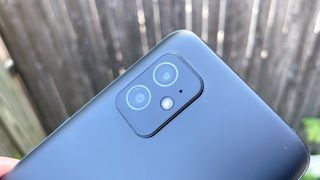
It might seem a bit unfair to pit the Zenfone 8 against the Pixel 5 in the camera department, as Google’s phone still ranks among the best camera phones. But both phones are similar in price, and this lets us see just how good of a bargain the Zenfone 8 really is.
In this shot of flowers, the Zenfone 8 overexposed the scene and the focus is a bit soft. The color of the flowers is vibrant, yes, but it teeters on being too bright. The Pixel, meanwhile, kept its shot toned down since the image was captured in shadow on a bright, sunny day. I wouldn’t call the Zenfone’s image bad, but the Pixel’s is definitely better.
I next took the phones to a part of the forest near my house. Again, you can see the slight differences between the two phones. The Zenfone is almost overexposed again, with greens that border on oversaturated. The Pixel kept the scene subdued and rich, with the green of the trees lush and verdant. Once more, the Zenfone’s shot is great, but the Pixel’s is better.
Moving indoors, the Zenfone 8 captured Merida’s likeness extremely well. The well-lit room certainly helped, but this image really impressed me, especially when compared to the Pixel’s photo. It’s hard to tell a difference between the two because they’re both excellent. The blue of Merida’s dress, the yellow candle, and the green fern all come together in a great composition.
The Zenfone 8 holds its own in the night mode department, too. In fact, I like its image better than the Pixel’s. It comes down to the noise. Yes, the Pixel 5 brought in more light, but at the cost of making the smoker noisy. The Zenfone 8 still brought in a ton of light, and the metal of the smoker is a bit smoother.
The Zenfone 8 does not put out nearly the same quality of portrait shot as the Pixel does. The Zenfone’s attempt has a terrible blur radius, overexposing on my face and doing too much face smoothing. The Pixel’s photo captures the wrinkles near my eyes, the dry skin I need to moisturize, and the individual curly hairs of my beard. While the Zenfone 8 has done well thus far, it can’t hold a candle to the Pixel’s portrait shot.
Finally, for selfies, you can’t go wrong with the Zenfone 8 and its 12MP front camera. It photographed me quite well, taking in the blue of my shirt, the black of my hat, and even the color of my eyes. The difference between the two selfies comes down to exposure and saturation. The Zenfone takes a similar approach to Samsung’s camera phones, boosting the colors in the scene, whereas the Pixel takes a more naturalistic approach, looking toned down overall. Regardless, I’d gladly post the Zenfone’s selfie.
Asus Zenfone 8 review: Performance
The Zenfone 8 sports a Snapdragon 888 processor with up to 16GB of RAM. It's a little powerhouse, crushing anything else Android-based in this size class — even the Pixel 5. This phone is no slouch, and it proves that both in real-world applications and in testing.
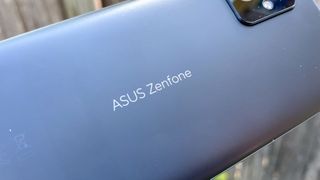
In Geekbench 5, the Zenfone 8 scored 1,120 in single-core and 3,659 in multicore. That’s right in line with the numbers we tallied with the Snapdragon 888-powered OnePlus 9, which were 1,126 and 3,618 respectively. Those are good scores, but the iPhone 12 mini beats both phones at 1,602 and 4,123, thanks to Apple’s A14 Bionic processor.
In the 3DMark Wild Life Unlimited graphics test, the Zenfone 8 achieved 34 frames per second, which lines up perfectly with the OnePlus 9. However, it still falls short of the iPhone 12 mini’s whopping 54 fps.
We’ve seen several Snapdragon 888 phones by this point, so it shouldn’t surprise anyone that the Zenfone 8 does as well as it does, even though it lags behind the iPhone 12 mini. In real life, though, the phone performs amazingly well. It’s snappy, quick, and I don’t notice any lag when performing certain tasks like opening an app in Recents.
Asus Zenfone 8 review: Battery life and charging
The Zenfone 8 packs a 4,000 mAh battery, which is quite large considering the phone’s physical size. In my use, the phone got decent battery life, enough to get me through most days. Push it hard with Google Duo calls or gaming and you might be looking for a charger before winding down for the day.
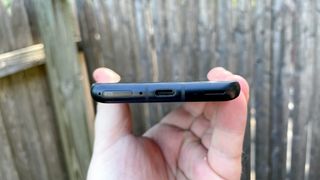
In the Tom’s Guide battery test, where a device is left to endlessly reload web pages on a cellular connection, the Zenfone 8 managed some decent times. In the 60 Hz mode, it lasted for 10 hours and 52 minutes, which is close to the 11-hour mark that devices on our best phone battery life list achieve.
Up the display to 90 Hz and the phone managed a respectable 10:16 result on our battery test. Bump it up to 120 Hz and the phone just barely fell below the 10-hour mark we’d like to see at 9:58. So you can get a lot of life out of the Zenfone 8, especially if you take the middle road and set the dislay’s refresh rate at 90 Hz. I’ve stuck with the auto mode and I’ve had no complaints about battery life.
We noticed some inconsistencies with charging speeds in our lab testing. Asus includes a 30W charger with the Zenfone 8, which should provide decent charging numbers. Instead, we saw that it only managed to recharge to 22% in 30 minutes. This heavily contrasts with Asus’ claims that it can recharge to 60% in 25 minutes.
Asus Zenfone 8 review: Software
Asus took a page from OnePlus’ book all the way back with the Zenfone 6. The company radically changed its software design to more closely resemble OxygenOS. The result was a clean, minimalistic UX with plenty of tweaks and features tucked away in settings. I remember remarking at the time that Asus had finally gotten ZenUI to a good place.
That decision continues all the way through the ROG Phone 5 and here with the Zenfone 8. ZenUI 8 looks a lot like what you’d find on a Pixel and it does a great job of doing what you want it to do and staying out of the way. Whereas OnePlus has since diverged a bit from Google’s vision, Asus sticks pretty close to it.

Based on Android 11, ZenUI has a few tricks up its sleeve to set it apart from stock Android. First off, the power button can act as a Smart Key, meaning that you can change its behavior. You can customize both a double click and a press and hold action. There are quite a few options to choose from, though I’ve stuck with launching the camera and bringing up the power menu on my review unit.
Elsewhere, you’ll find a gaming mode to reduce distractions while you’re gaming and push the Zenfone 8 to its max for intensive titles. Asus’ OptiPlex feature, wherein the software learns your habits and pre-loads commonly used apps, returns once again. You can disable or tweak it to your liking. There’s also a one-handed mode, making this small phone even easier to use single-handed.
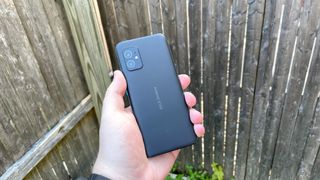
So far, Asus has not committed to any number of software updates for the Zenfone 8. We’re hoping for at least three as the company continues to put an emphasis on good software. Stay tuned for an update on this once we get confirmation.
Asus Zenfone 8 review: Verdict
The Asus Zenfone 8 is a great phone, though its availability might leave some confused. But the hardware is excellent, the software is great, and the cameras perform way better than expected (especially after the extreme disappointment I had with the ROG Phone 5’s cameras). You’re getting a ton of phone with the Zenfone 8 and it’s definitely the best small Android phone, handily beating the Pixel 5 in every way except camera performance.
I have few qualms with recommending this Zenfone 8, especially compared to some of its Android competitors, like the OnePlus 9. The value proposition is strong here, even though we don’t know full pricing just yet.
But at a starting price of €599, this is one hell of a phone to beat. While it may not hold OnePlus’ feet to the fire in terms of scale, it certainly gives the OnePlus 9 a run for its money and should have the upcoming Pixel 6 quaking in its boots.

Jordan is the Phones Editor for Tom's Guide, covering all things phone-related. He's written about phones for over six years and plans to continue for a long while to come. He loves nothing more than relaxing in his home with a book, game, or his latest personal writing project. Jordan likes finding new things to dive into, from books and games to new mechanical keyboard switches and fun keycap sets. Outside of work, you can find him poring over open-source software and his studies.

